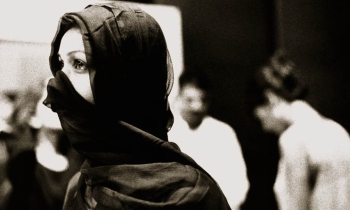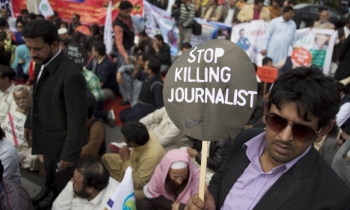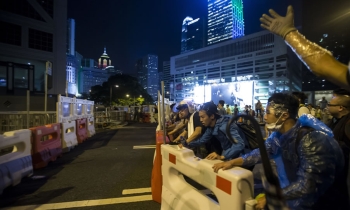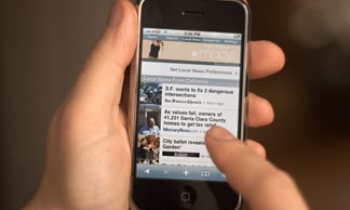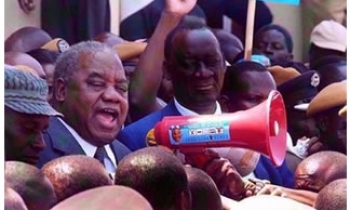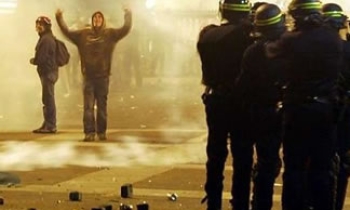Israel is fast catching up with its adversaries in its attacks on the press. Seven journalists and media workers were injured in a space of two days during attacks carried out by Israeli forces in Lebanon earlier this week. Two Palestinian photographers were shot at last week in the Gaza area.

Israeli aircraft fired two missiles at the Al-Manar television channel's headquarters in the southern Beirut suburb of Haret Hreik on July 13. Two employees were injured by flying glass, and a civilian in a nearby house was also wounded. The top floors of the building were severely damaged. However, the station continued to broadcast. Israeli forces separately struck two Al-Manar TV transmitters, one near Baalbek, northeast of Beirut, and another in Maroun al-Ras in southern Lebanon.
Al-Manar, which is linked to Hezbollah, the political group whose armed wing is involved in violent attacks against Israel, is a controversial network whose broadcasts have been banned by some countries in the West, notably France.
The Geneva Conventions prohibit attacks on civilian targets unless they are used for military purposes. While Al-Manar may serve a propaganda function for Hezbollah, it does not appear based on a monitoring of its broadcasts today to be serving any discernible military function, the Committee to Protect Journalists (CPJ) said. "Israel should immediately explain the basis for these strikes on Al-Manar," said CPJ Executive Director Joel Simon.
Al-Manar managing director, Ali-Al-Haji, told CPJ that the strikes took place as part of an Israeli military offensive in Lebanon that began after Hezbollah guerillas abducted two Israeli soldiers and killed another eight near the Lebanese-Israeli border the previous day. More than 50 Lebanese civilians were killed in Israeli air strikes. "We call on all sides in this conflict to respect the work of journalists covering the fighting," Simon added. "Journalists like all civilians cannot be targeted under the rules of war."
In a separate development on July 13, Reuters reported that cameraman Rami Amichai was wounded in the leg by shrapnel in a Hezbollah rocket attack. Amichai had been filming in the Israeli coastal city of Nahariya when a rocket struck nearby, sending shrapnel flying into his lower leg, Reuters said. He was taken to hospital for treatment.

On July 12, three journalists working for the Lebanese satellite television channel New TV were seriously wounded when their car was struck during Israel's bombardment of the al-Mahmoudiyeh Bridge in southern Lebanon, New TV producer Sana' Salami told CPJ. Reporter Bassel al-Aridi, cameraman Abed Khayat, and assistant cameraman Ziad Sawan were seriously injured. Their vehicle was destroyed. The journalists are now recovering in the American University of Beirut hospital.
"We are very alarmed by the sudden attack on the New TV crew and we call on the authorities to protect journalists," Reporters sans Frontières (RSF) said. "It is unacceptable that journalists should be treated as combatants when they are covering clashes. We point out that this would not be the first time the Israeli army has deliberately targeted journalists."
New TV said, "The three journalists did not hear the helicopter arrive and do not remember what happened after the shots were fired, recovering consciousness in hospital. They lives are not in danger. They were taken to Natatiye hospital 70 km southeast of Beirut." Their vehicle was clearly marked with the New TV logo. One of the injured journalists said the New TV vehicle suffered more damage than any other, "which suggests to us that it was a targeted attack against our vehicle."
The International Federation of Journalists (IFJ) condemned the Israeli bombing of Al-Manar, and said the attack follows a pattern of media targeting that threatens the lives of media staff, violates international law and endorses the use of violence to stifle dissident media.
"The bombing of Al-Manar is a clear demonstration that Israel has a policy of using violence to silence media it does not agree with," said IFJ General Secretary Aidan White. "This action means media can become routine targets in every conflict. It is a strategy that spells catastrophe for press freedom and should never be endorsed by a government that calls itself democratic."

IFJ says there has been an increase in the targeting of media since the 1999 NATO bombing in Belgrade of Serbian broadcaster RTS which killed 16 people. At the time, NATO said the station was a legitimate military target because it was a "propaganda mouthpiece" for the regime of Slobodan Milosevic regime. But, IFJ had said then, there was no justification for the action under international law and warned the strike would set a precedent for attacks on media whenever a conflict breaks out.
These fears, IFJ said in a release, were confirmed in 2002 when Israel bombed facilities of the Palestine radio and television broadcasting corporation in Gaza and Ramallah, and when US forces attacked the offices of television network Al-Jazeera, first in Kabul during the war in Afghanistan and again in Baghdad during the 2003 invasion of Iraq when the network's offices were bombed killing journalist Tareq Ayyoub.
"The concern here is that when one side decides to take out a media organisation because they regard its message as propaganda, then all media are at risk," said White. "In conflict situations, unarmed journalists cannot be treated as combatants, irrespective of their political affiliations."
The Israeli attacks on TV stations in Lebanon follows close on the heels of the shooting of photojournalists in Gaza last week. Hamdi Al Khur, a photographer with the Turkey-based Ihlas News Agency was shot twice by Israeli snipers on July 7 while filming clashes between Palestinian militants and Israeli troops in the northern Gaza Strip town of Beit Lahiya, acording to the International Press Institute (IPI).
The first shot, aimed at the chest did not cause serious injury as Al Khur was protected by the flak jacket he was wearing. The second shot hit his right arm. Doctors at the Kamal Edwin hospital, where Al Khur was treated after the shooting, were unable to remove all the shrapnel from his arm and called for an emergency evacuation on July 8 to a Jerusalem hospital. Al Khur continues to receive treatment there and it is not yet known when he will be able to return home.

Mohammad Az Zanoun, a photographer with the Palestinian online news agency Ma'an, was covering events in his home district of Zaitoun, east of Gaza City, when Israeli tanks entered the area on the morning of July 8. Zanoun was fired upon while photographing two Palestinian militants who had been killed in the incursion. The first bullets, fired from an Israeli tank, ricocheted off a brick wall next to where Zanoun was standing. He was hit in the face by shrapnel and debris, the force of which fractured his skull and caused serious damage to his right eye and ear.
When Zanoun attempted to continue photographing, he was shot in the leg and stomach by an Israeli sniper. He was taken to hospital by car, as no ambulances were able to reach him. He underwent surgery at the Al Shifa'a hospital in Gaza City. He has since been evacuated to an Israeli hospital where he remains in serious condition.
IPI Director Johann P Fritz said "The shooting of two photographers in two days is a deeply worrying development and raises serious concerns for the safety of journalists covering the escalating tension in the region. Given that both Al Khur and Zanoun were wearing bright yellow vests, clearly identifying them as members of the press, it is impossible to believe they could have been mistaken for combatants."
"According to the Geneva Conventions and customary international law, journalists, like all civilians, should be protected from the dangers arising from military operations. All parties to the current conflict must recognise that journalists and media workers cannot be treated as combatants and cannot be targeted in retaliation for carrying out their professional duties," said Fritz.
"These ruthless attacks must stop," said Naim Tobassi, President of the Palestinian Journalists' Syndicate (PJS). "The PJS firmly believes that there is attempt by the Israeli authorities to put a dark veil over all these crimes. We have sent a letter to Prime Minister Olmert and to the Israeli Minister of Defence to call on them to take measures to protect Palestinian journalists."

Nine journalists and media staffers have been killed in the Occupied Territories since 2000, all by Israeli gunfire. In most cases, the army has failed to conduct serious investigations or publicly account for them.
All has not been well on the Gaza front. Israel defence forces last month announced that Israeli passport holders and dual nationals would be prohibited from entering Gaza. The restriction followed an attack by Palestinian militants on an Israeli military post in which two soldiers were killed and a third abducted. Citing security concerns, Israeli authorities that day closed to all media the Erez crossing, the main passage from Israel into the Gaza Strip. The travel ban was lifted after protests from foreign journalists and the Foreign Press Association in Israel.
Authorities have often banned Israeli citizens from entering the West Bank and Gaza, but journalists are typically allowed to cross the border if they sign waivers absolving Israeli authorities of responsibility.
Israeli soldiers also attacked Palestinian journalists covering unrest in the West Bank city of Nablus on a number of occasions earlier this year.
On April 17, soldiers fired at a group of cameramen and photographers covering an Israeli army raid on a house in the Old City of Nablus. Nasser Ishtayeh and Abdal Ruhman Khabeisa of the Associated Press, Jaffar Ishtayeh of Agence France-Presse, and Abdel Rahim Qusini and Hassan Titi of Reuters said they were filming the raid, and clashes between soldiers and stone-throwing youths, from a distance of about 500 yards (meters), beside an AP vehicle that was clearly marked "Press."

They were wearing phosphorus green vests labeled "Press." Titi placed a video camera on a stand 3 ft from the car. Israeli soldiers fired at the camera forcing the journalists back into the vehicle, which also came under fire.
Ishtayeh told CPJ that an Israeli army jeep also tried to run him over along with other Palestinian journalists who were trying to cover an army action on April 25. The journalists were on a main road reporting on the eviction of families from a building during a military raid in the al-Makhfiyeh neighbourhood of Nablus. A soldier threatened the journalists and sped toward them in a jeep, forcing them from the road.
On April 22, Reuters cameraman Ashraf Abu Shaweesh was hit by rubber bullets when filming clashes between Palestinian protesters and the Israeli army in Nablus. Shaweesh, who was wearing a vest that identified him as a journalist, became involved in a verbal confrontation with a soldier. Later he was hit twice, in the leg and chest, by rubber bullets.
A Turkish cameraman was a target of bullets of Israeli soldiers on July 7 when he was taking footage in the Eretz Industry Zone. According to Anatolia news agency, Turkish Ihlas News Agency's (IHA) cameraman Hamdi Hur climbed an electricity pole to record the atmosphere in the industrial zone and was a target of bullets of Israeli soldiers. While one bullet hit his steel vest, he was wounded in his hand by another. Hur was immediately taken to a hospital in Gaza Strip.

